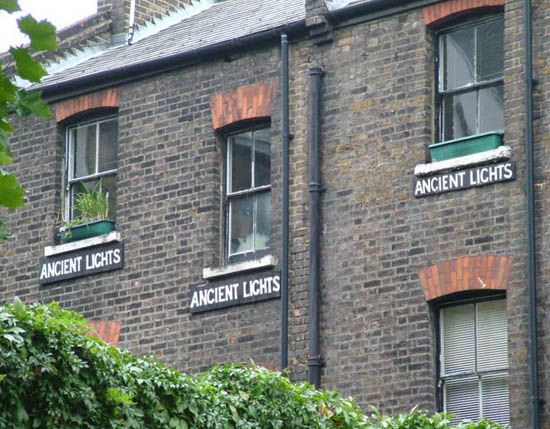 [Image: Via Wikipedia].
[Image: Via Wikipedia]."Ancient lights" is a colloquialism for the "right to light," guaranteed under English law, whereby windows that have seen twenty years' worth of "uninterrupted" daylight cannot be blocked by the construction of new buildings.
Or, as Wikipedia explains it:
- In effect, the owner of a building with windows that have received natural daylight for 20 years or more is entitled to forbid any construction or other obstruction that would deprive him of that illumination. Neighbors cannot build anything that would block the light without permission. The owner may build more or larger windows but cannot enlarge his new windows before the new period of 20 years has expired.
Whether "this term" refers to sufficient light or to ordinary notions of mankind is hard to tell.
In any case, the Royal Institution of Charted Surveyors, or RICS, suggests that you should never "settle for living in the shadows."
The RICS believes, in fact, that "many people are allowing adjacent buildings to block their natural light, unaware that they have a legal right to it. Light blocking can be classified as a ‘nuisance’ alongside noise and air pollution and culprits range from large new commercial developments to a neighbour’s building extension or a new garden shed. Even a tall hedge can be a problem."
The tone of the RICS abruptly shifts at this point, however, as they begin to explain how you can actually prevent your neighbors from acquiring ancient light rights. There is a "need for vigilance to prevent neighbours acquiring a right to light," they warn; after all, such an acquisition "may hamper future development and investment possibilities" on your own property.
"It is possible to prevent a building acquiring a right to light," the RICS explains, "but despite the procedure being simple, it is rarely used." The "procedure" involves a man called Vinnie, and he –
The actual solution is a kind of ghost architecture. In other words, following consultation from the RICS, you draw "a notional screen of unlimited height," along with other "imaginary legal partitions," around your home, thus defining the light rights of your property.
You then ring your neighbor's doorbell, hand him an envelope, and explain what you've been doing. He nods quietly, ceases construction on his new guest bedroom – and then throws a brick through your window.
You retaliate.
The other neighbors soon join in, choosing sides, talking strategy, letting the air out of your car's tires and stealing your newspaper. Within a week, the quality of life on your street has plummeted; there are threats, loud noises, and an unexplained smell...
Meanwhile, "[i]n the center of London, near Chinatown and Covent Garden, particularly in back alleyways, signs saying 'Ancient Lights' can be seen marking individual windows."
('Ancient Lights' found via del.icio.us/fakeisthenewreal).
No comments:
Post a Comment